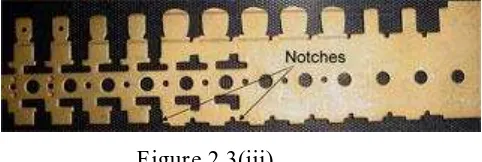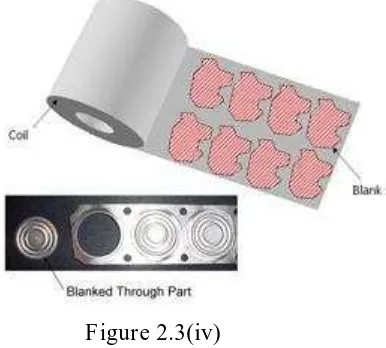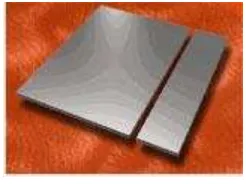UTeM Library (Pind.1/2007)
UNIVERSITI TEKNIKAL MALAYSIA MELAKA
BORANG PENGESAHAN STATUS LAPORAN PSM
JUDUL:
“Design and Model Making of Forming Die”
SESI PENGAJIAN: Semester 2 2007/2008
Saya Muhammad Nurul Hafiz Bin Abd Malik
mengaku membenarkan laporan PSM / tesis (Sarjana/Doktor Falsafah) ini disimpan di Perpustakaan Universiti Teknikal Malaysia Melaka (UTeM) dengan syarat-syarat kegunaan seperti berikut:
1. Laporan PSM / tesis adalah hak milik Universiti Teknikal Malaysia Melaka dan penulis.
2. Perpustakaan Universiti Teknikal Malaysia Melaka dibenarkan membuat salinan untuk tujuan pengajian sahaja dengan izin penulis.
3. Perpustakaan dibenarkan membuat salinan laporan PSM / tesis ini sebagai bahan pertukaran antara institusi pengajian tinggi.
4. *Sila tandakan (√)
SULIT
TERHAD
TIDAK TERHAD
(Mengandungi maklumat yang berdarjah keselamatan atau kepentingan Malaysia yang termaktub di dalam AKTA RAHSIA RASMI 1972)
(Mengandungi maklumat TERHAD yang telah ditentukan oleh organisasi/badan di mana penyelidikan dijalankan)
FAKULTI KEJURUTERAAN PEMBUATAN
Rujukan Kami (Our Ref) : 17 Oktober 2012
Rujukan Tuan (Your Ref):
Pustakawan
Perpustakaan Universiti Teknikal Malaysia Melaka (UTeM) Taman Tasik Utama, Hang Tuah Jaya,
Ayer Keroh, 75450, Melaka
Saudara,
PENGKELASAN LAPORAN PSM SEBAGAI SULIT/TERHAD
- LAPORAN PSM SARJANA MUDA KEJURUTERAAN PEMBUATAN (REKABENTUK PEMBUATAN): Muhammad Nurul Hafiz Bin Abd Malik
TAJUK: Design and Model Making of Forming Die
Sukacita dimaklumkan bahawa tesis yang tersebut di atas bertajuk “Design and Model Making of Forming Die
” mohon dikelaskan sebagai terhad untuk tempoh lima (5) tahun dari tarikh surat ini memandangkan ia mempunyai nilai dan potensi untuk dikomersialkan di masa hadapan.
Karung Berkunci 1200, Ayer Keroh, 75450 Melaka
DECLARATION
I hereby declare that this report entitled “Design and Model Making of Forming Die”
is the result of my own research except as cited in the references.
Signature :
Author’s Name : Muhammad Nurul Hafiz Bin Abd Malik
APPROVAL
This report is submitted to the Faculty of Manufacturing Engineering of UTeM as a partial fulfillment of the requirements for the degree of Bachelor of Manufacturing Engineering ("Specify your specialization here (e.g. Process)" ). The members of the
supervisory committee are as follow:
Mr. Wahyono Sapto Widodo
(PSM Supervisor)
Faculty of Manufacturing Engineering: Design And Model Making of Forming Dies i
1.2 Problems Statements ………... 2
1.2.1 Stretch Ability ………... 3
2.5 Solid Ford/Dead Hit Dies ………. 10
2.6 Drawing Dies ……… 11
2.7 Flanging Dies ……… 11 2.8 Ironing Dies ……….. 12
2.9 Extruding Dies ……….. 12
Faculty of Manufacturing Engineering: Design And Model Making of Forming Dies ii
2.11 Dies Component and Accessories ………13
2.11.1 Die Plates, Shoes, and Die Sets ………..13
2.11.2 Guide Pins and Bushing ………..14
2.11.3 Heel Blocks and Heel Plates ………...…………15
2.11.4 Screws, Dowels, and Keys ………..17
2.11.5 Pads ……….………...…….17
2.11.6 Stripper Pad ………...18
2.11.7 Pressure Pad………..19
2.11.8 Draw Pad………..19
2.11.9 Spools, Shoulder Bolts, and Keepers ………...20
2.11.10 Retainer...……….21
2.11.11 Spring ……….22
3. Methodology ……….23
3.1 Developing Forming Die ………..23
3.2 Finite Element Analysis ………25
3.2.1 Determine The Part Metal Type, Grade, and Thickness ……….26
3.2.2 Part Study ………27
3.2.3 Conduct a Length-of-Line Analysis ………28
3.2.4 Determine the Tip Angel ……….29
3.2.5 Unfold the Parts ………...30
3.2.6 Develop the Blank Holder Shape………..31
3.2.7 Add Addendum Feature ………...………32
3.3 Machining Model ………...…33
4.1.1 Design Details for Lower Part ………..39
4.2 Upper Die Design ………...……42
Faculty of Manufacturing Engineering: Design And Model Making of Forming Dies iii
4.3 Die Set ………...46
4.3.1 Die Set Details ………..47
4.4 Machining Result for Model ..………51
5. Discussion ………..……… 53
Faculty of Manufacturing Engineering: Design And Model Making of Forming Dies iv
Figure 2.5 Solid Form/Dead Hit Dies ………10
Figure 2.6 Drawing Dies ………11
Figure 2.7 Flanging Dies ………11
Figure 2.8 Ironing Dies ………..12
Figure 2.9 Extruding Dies ………..12
Figure 2.10 Coining Dies ………13
Figure 2.11.1 Die Plates, Shoes, and Die Sets ………13
Figure 2.11.2 Guide Pins and Bushing ………15
Figure 2.11.3 Heel Blocks and Heel Plates ……….16
Figure 2.11.4 Screws, Dowels, and Keys ………17
Figure 2.11.6 Stripper Pad ………...18
Figure 2.11.7 Pressure Pad ………..19
Figure2.11.8 Draw Pads ………..20
Faculty of Manufacturing Engineering: Design And Model Making of Forming Dies v
Figure 2.11.10 Retainer ………..21
Figure 2.11.11 Spring ……….22
Figure 3.2.1 Material Properties ……….26
Figure 3.2.3 Length-of-Line Analysis ………28
Figure 3.2.4 Tip Angel ………29
Figure 3.2.5 Unfold Parts ………31
Figure 3.2.6 Blank Holder ………...32
Figure 3.2.7 Addendum Feature ………..33
Figure 3.4.1 Aluminum Characteristic ………35
Table 3.41 Aluminum Properties ……….36
Figure 4.0 Drawing Design ………..37
Figure 4.3 Die Set ………46
Figure 4.4 Machining Process and Results ………..51
Faculty of Manufacturing Engineering: Design And Model Making of Forming Dies vi
Acknowledgement
I would like to acknowledge the contributions of the following groups and individuals to the development of my thesis for final year project;
1) Mr. Wahyono Sapto Widido (Lecturer, Faculty of Manufacturing Engineering)
Mr. Wahyono is my advisor for this project, who guide me from the beginner of this project and give valuable information regarding the forming dies process. He also give me reading and reference material for me to complete the thesis.
2) Mr. Norizal Arshad (Student, Faculty of Mechanical Engineering)
This individual really helps me especially on dies and mold making principle. He is an experienced individual who has been through into the industrial sector before continue his study in UTeM for degree, and he also give me reading materials for the dies.
3) UTeM Librarian
UTeM Librarian directed me to a wide range of resources on the web and in the library stacks. They answered all of my questions as well as asked me questions that helped me to narrow my search.
4) AMC Technicians (Especially Mr. Raduan Khalil)
Faculty of Manufacturing Engineering: Design And Model Making of Forming Dies 1
Abstract
Forming dies are typically manufactured by those who produce dies, in example the tools and dies maker and put into production after mounting into a press. The die is a metal block that is used for forming materials like sheet metal and plastic. In this study and scope of research, I have studied about the forming of sheet metal. Two parts may be used, one, called the punch (upper die), performs the stretching, bending, and blanking operation, while another part, called the die block (lower die), securely clamps the work piece and provides similar, stretching, bending, and/or blanking operation. The work piece may pass through several stages using different tools or operations to obtain the final form. In this case study/research, I’m designing a simple dies and try to produce the part of the dies using CNC machine in Advance Manufacturing Centre in UTeM. This thesis also included the problem statement
before and after the process of making forming dies. But I’m not producing any part
from the dies because I’m not making the die set for forming process. This is because usually the part is make in mass production and the cost is more cheaper when buying
all those part than produce it ourselves. For this manufacturing of the dies, I’m using
Faculty of Manufacturing Engineering: Design And Model Making of Forming Dies 2
CHAPTER 1
Introduction
1.1 Background
In this thesis, we will go through the procedure and the method of producing the forming dies; one of the most popular die processes in the industry. Basically, the forming die is not much different from drawing dies. The different between these two types of process is only the capability of the method. The drawing die is usually used to produce higher level product with deeper depth, while forming dies only cover the thin depth.
1.2 Problems Statements
For this research, the metal that being decide to form into product is aluminums. Aluminums is not a metal, this is because it not behave like steels, and it certainly
doesn’t stretch like steels. Like any other metals, it has advantages and disadvantages.
Some of the characteristic and behaviors that being study before producing aluminums parts are:
1. Stretch Ability 2. Draw Ability
Faculty of Manufacturing Engineering: Design And Model Making of Forming Dies 3
1.2.1 Stretch ability
Aluminum does not have near the elongation ability of steel. For instance, typical deep-drawing steel has elongation somewhere around 45 percent, while a 3003–O temper, so aluminum will have elongation near 30 percent.
1.2.2 Draw ability
Draw ability is the metal's ability to flow plastically when subjected to tension, while stretch ability is the increase of surface area as the result of tension. Depending on the type, aluminum can draw very well. It has a good strength-to-weight ratio and is well-suited to the deep-drawing process, as well as multiple draw reductions. The reductions percentages are very comparable to those often used when drawing deep-drawing steel.
1.2.3 Compressibility
During ironing, the metal is squeezed down a vertical wall to increase the surface area while reducing the metal's thickness. It increases the metal sheet's surface area by squeezing the metal rather than exposing it to tension. Ironing is the basic process used to make beverage cans. When aluminum is ironed, it almost compressively flows like a hot liquid down the wall of the die cavity and punch, and it shines to a mirror like surface finish. In this case of process, the aluminums will not having any problems to form in the forming process.
1.2.4 Springback
Aluminum has more springback than soft draw-quality steel. However, the amount of
Faculty of Manufacturing Engineering: Design And Model Making of Forming Dies 4
1.3 Objective(s)
The objectives of this research are:
a) To design a forming die of a press part b) To make CNC program for forming die c) To machining a model using a CNC machine
1.4 Scope of Study
Faculty of Manufacturing Engineering: Design And Model Making of Forming Dies 5
CHAPTER 2
Literature Review
2.1 The Basics of Dies
All forming operations deform sheet material by exposing it to tension, compression, or both. Most part defects, such as splits and wrinkles, occur in forming operations. Successful sheet metal forming relies heavily on the metal's mechanical properties. The metal being formed must have the ability to stretch and compress within given limits. It also must be strong enough to satisfy the part's fit and function. This balance between formability and strength often is hard to achieve. Most forming operations involve at least two basic components: a punch, representing the male portion of the die, and the cavity, representing the female portion.
2.2 Stamping Die
Faculty of Manufacturing Engineering: Design And Model Making of Forming Dies 6
one piece part per cycle and can cycle as fast as 1,500 cycles (strokes) per minute. Force from a press enables the die to perform.
Figure 2.2
There are many kinds of stamping dies, all of which perform two basic operations like cutting, forming, or both. Manually or robotically loaded dies are referred to as line dies. Progressive and transfer dies are fully automated.
2.3 Cutting
Faculty of Manufacturing Engineering: Design And Model Making of Forming Dies 7 Figure 2.3(i)
There are many different cutting operations, each with a special purpose. Some common operations are:
a) Trimming
The outer perimeter of the formed part or flat sheet metal is cut away to give the piece part the desired profile. The excess material usually is discarded as scrap.
Figure 2.3(ii)
b) Notching
Usually associated with progressive dies, notching is a process in which a cutting operation is performed progressively on the outside of a sheet metal strip to create a given strip profile.
Faculty of Manufacturing Engineering: Design And Model Making of Forming Dies 8
c) Blanking
A dual-purpose cutting operation usually performed on a larger scale, blanking is used in operations in which the slug is saved for further press working. It also is used to cut finished piece parts free from the sheet metal. The profiled sheet metal slug removed from the sheet by this process is called the blank or starting piece of sheet metal that will be cut or formed later.
Figure 2.3(iv)
d) Piercing
Faculty of Manufacturing Engineering: Design And Model Making of Forming Dies 9
Figure 2.3(v)
e) Lancing
In lancing, the metal is sliced or slit in an effort to free up metal without separating it from the strip. Lancing often is done in progressive dies to create a part carrier called a flex or stretch web.
Figure 2.3(vi)
f) Shearing
Shearing slices or cuts the metal along a straight line. This method commonly is used to produce rectangular and square blanks.
Faculty of Manufacturing Engineering: Design And Model Making of Forming Dies 10
2.4 Embossing Dies
Embossing dies use tension to stretch metal into a shallow depression. The dies primarily are comprised of a punch and a cavity. The metal's thickness and mechanical properties, along with the forming punch geometry, determine the depth that can be achieved.
Figure 2.4
2.5 Solid Form/Dead Hit Dies
Solid form/dead hit dies; also called crash forming dies deform the metal using only a punch and cavity. These dies do not control metal flow and cannot prevent the metal from wrinkling or buckling. They are used to form simple parts, such as brackets and braces, made from thick, stiff metals that are more wrinkle resistant than thinner metals. Because this operation also uses tension to form the part, attempting to solid-form difficult part geometries using thin metal often results in severe failure.
2.6 Drawing Dies
Figure 2.5
Faculty of Manufacturing Engineering: Design And Model Making of Forming Dies 11
Drawing dies are the most impressive forming dies. Oil pans, automobile doors and fenders, cookware, and door knobs are just a few parts manufactured by drawing. Draw dies create the part shape by controlling metal flow into a cavity and over the forming punch. Draw dies utilize a special pressure-loaded plate or ring called a draw pad or blank holder to control the metal's flow into the cavity. This plate prevents the metal from wrinkling as it flows into the cavity. Increasing or decreasing the pressure exerted under the pad also controls how much metal feeds into the die. Although compression can occur when the metal is drawn, drawing uses mostly tension to obtain the part geometry.
Figure 2.6
2.7 Flanging Dies
Flanging is bending metal along a curved axis. Two basic types of flanges are tension, or stretch, flanges, and compression, or shrink, flanges. Tension flanges are susceptible to splitting, and shrink flanges are susceptible to wrinkling. Flanges are created using a flanging die that wipes the metal between a punch and a lower die section. Both tension and compression occur during the flanging process.
Faculty of Manufacturing Engineering: Design And Model Making of Forming Dies 12
2.8 Ironing Dies
Ironing dies are similar to coining dies in that they deform the metal with compression. However, unlike conventional coining, ironing squeezes metal along a vertical wall. This highly compressive process unifies a wall's thickness and increases the drawn vessel's length. Items such as beverage and soup cans are made using an ironing process. Ironing allows an aluminum can's wall thickness to be reduced to as little as 0.002 in.
Figure 2.8
2.9 Extruding Dies
In extruding, the metal is flanged around the perimeter of a prepierced hole. Like during stretch flanging, the metal is susceptible to splitting during forming. Extrusions also are referred to as hole expansions or continuous stretch flanges. Often extrusions are tapped for holding fasteners used in the part assembly process.
Faculty of Manufacturing Engineering: Design And Model Making of Forming Dies 13
2.10 Coining Dies
Coining dies create the part's shape by squeezing the metal under extreme pressure. Coining also can reduce the metal thickness. Coins (metal currency) are created with the coining process. A simple round metal slug is placed into the die and forced to flow into a given shape by compressing it.
Figure 2.10
2.11 Dies Component and Accessories
Most stamping dies are constructed of several basic components, including die plates, shoes, die sets, guide pins, bushings, heel blocks, heel plates, screws, dowels, and keys. Dies also need stripper, pressure, and drawing pads, as well as the devices used to secure them: spools, shoulder bolts, keepers, and retainers, as well as gas, coil, or urethane springs.
2.11.1 Die Plates, Shoes, and Die Sets







